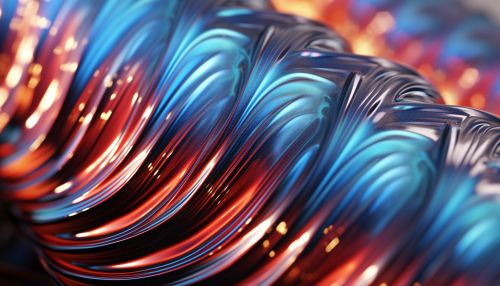Cholesteric phase
Introduction
The cholesteric phase, also known as the chiral nematic phase, is a type of liquid crystal phase that exhibits a unique helical structure. This phase is characterized by the orientation of the constituent molecules, which form a layered structure with each layer slightly rotated from the previous one, resulting in a helical arrangement. The cholesteric phase is named after cholesterol, from which it was first observed.
Structure and Properties
The cholesteric phase is characterized by a unique helical structure, where the molecules in each layer are slightly rotated from the previous layer. This rotation is typically in the range of 0.1 to 2 degrees per layer. The pitch, or the distance over which the molecules make a full 360-degree rotation, is typically in the range of 100 to 1000 nanometers, depending on the specific liquid crystal material and the temperature.


The helical structure of the cholesteric phase gives rise to interesting optical properties. For instance, the phase is optically active, meaning it can rotate the plane of polarization of light. This property is used in various applications, such as in the creation of circular polarizers and in the design of certain types of liquid crystal displays.
The cholesteric phase also exhibits selective reflection, where light of a certain wavelength (color) is reflected while other wavelengths are transmitted. The reflected wavelength is determined by the pitch of the helical structure and the average refractive index of the liquid crystal material. This property is the basis for the creation of cholesteric liquid crystal displays, which can display colors without the need for color filters.
Formation of the Cholesteric Phase
The cholesteric phase can be formed by certain types of liquid crystal materials that possess chirality. Chirality is a property of a molecule that cannot be superimposed on its mirror image. In the context of liquid crystals, chirality can be introduced by incorporating a chiral center into the molecule, or by adding a chiral dopant to a nematic liquid crystal.
The formation of the cholesteric phase is a thermotropic phenomenon, meaning it is dependent on temperature. As the temperature changes, a liquid crystal material can transition between different phases. For instance, a chiral nematic liquid crystal may transition from the isotropic phase (where the molecules have no preferred orientation) to the nematic phase (where the molecules align along a common axis) and then to the cholesteric phase as the temperature decreases.
Applications
The unique properties of the cholesteric phase have led to its use in a variety of applications. One of the most common applications is in liquid crystal displays (LCDs). Cholesteric LCDs, also known as ChLCDs, utilize the selective reflection property of the cholesteric phase to display colors without the need for color filters. This makes ChLCDs more energy efficient than traditional LCDs.
The cholesteric phase is also used in the creation of circular polarizers, which are used in various optical applications. Additionally, the phase is used in the design of temperature sensors, as the pitch of the helical structure (and thus the color of the reflected light) changes with temperature.
